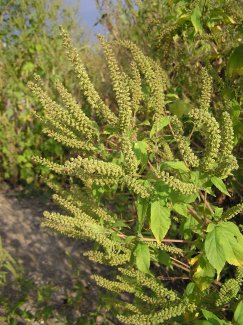Eastern Canada: Canada - New Brunswick, - Nova Scotia, - Ontario, - Prince Edward Island, - Quebec
North-Central U.S.A.: United States - Illinois, - Iowa, - Kansas, - Minnesota, - Missouri, - Nebraska, - North Dakota, - Oklahoma, - South Dakota, - Wisconsin Northeastern U.S.A.: United States - Indiana, - Michigan, - Ohio, - Pennsylvania, - West Virginia Northern Mexico: Mexico - Chihuahua, - Coahuila, - Sonora Northwestern U.S.A.: United States - Colorado, - Montana, - Wyoming South-Central U.S.A.: United States - Texas Southeastern U.S.A.: United States - Alabama, - Arkansas, - Georgia, - Kentucky, - Louisiana, - Maryland, - Mississippi, - North Carolina, - South Carolina, - Tennessee, - Virginia
Western Canada: Canada - Alberta, - British Columbia, - Manitoba, - Saskatchewan
This is an annual herb usually growing up to 2 m (6 ft 7 in) tall, but known to reach over 6 m (20 ft) in rich, moist soils. The tough stems have woody bases and are branching or unbranched. Most leaves are oppositely arranged. The blades are variable in shape, sometimes palmate with five lobes, and often with toothed edges. The largest can be over 25 cm (9.8 in) long by 20 cm (7.9 in) wide. They are borne on petioles several centimeters long. They are glandular and rough in texture. The species is monoecious, with plants bearing inflorescences containing both pistillate and staminate flowers. The former are clustered at the base of the spike and the latter grow at the end. The fruit is a bur a few millimeters long tipped with several tiny spines.
A. trifida has little utility. In a few instances, it may be grown as an ornamental planting, but is not widely used for that purpose because of its unattractive flowers and rough, robust vegetative growth.
